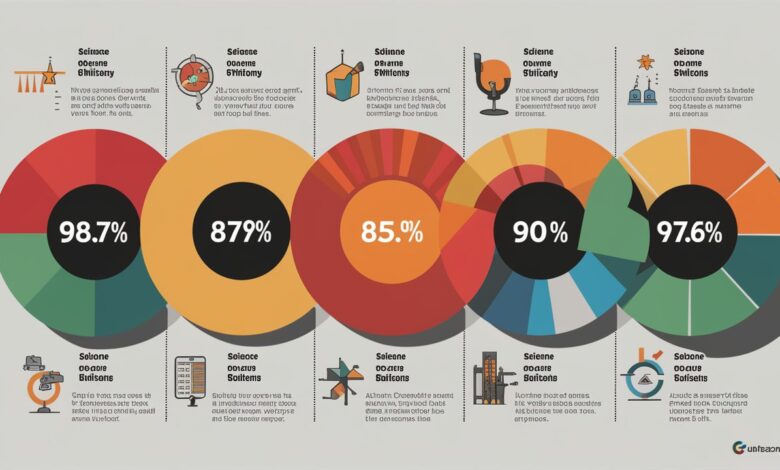Decoding Success: The Science Behind 98.7 87.8 85.9 90 97.6 Efficiency Rates

In an era driven by data, numbers like 98.7 87.8 85.9 90 97.6 often represent critical benchmarks in fields ranging from healthcare to technology. These figures are not arbitrary; they reflect efficiency, success rates, or performance metrics that shape industries and inform decision-making. This article explores the significance of these percentages, their real-world applications, and the lessons they offer for optimizing outcomes. Whether you’re a professional seeking to improve processes or a curious learner, understanding these metrics provides actionable insights into achieving excellence.
The 98.7% Benchmark: The Gold Standard of Precision
The figure 98.7% often symbolizes near-perfection in systems requiring minimal error margins. For example, in pharmaceutical manufacturing, a 98.7% purity rate in drug formulation ensures patient safety and regulatory compliance. Similarly, in artificial intelligence, machine learning models achieving 98.7% accuracy in image recognition are considered state-of-the-art. This percentage underscores the importance of precision in high-stakes environments. However, reaching this level demands rigorous quality control, advanced technology, and iterative testing. Even a 1.3% deviation can lead to significant consequences, such as misdiagnoses in healthcare or flawed predictions in finance.
87.8%: Balancing Efficiency and Practical Constraints
The 87.8% metric often appears in contexts where trade-offs between efficiency and feasibility are unavoidable. For instance, renewable energy systems might operate at 87.8% capacity due to environmental variability, while customer satisfaction surveys might reflect this rate when balancing service quality and resource limitations. This percentage highlights the reality that perfection is often unattainable—instead, optimizing within constraints is key. Organizations aiming for 87.8% must focus on incremental improvements, employee training, and adaptive strategies to bridge gaps without overextending resources.
85.9%: The Threshold of Competitive Viability
In competitive markets, 85.9% frequently represents the threshold for viability. For example, e-commerce platforms with 85.9% order fulfillment rates risk losing customers to faster competitors, while schools with 85.9% graduation rates may face scrutiny over equity gaps. This figure serves as a wake-up call to identify systemic weaknesses, whether in supply chains, educational access, or product reliability. Addressing the missing 14.1% often requires root-cause analyses, stakeholder collaboration, and innovative problem-solving to transform shortcomings into strengths.

90%: The Universal Marker of Reliability
A 90% success rate is widely regarded as a hallmark of reliability. In tech, software with 90% uptime is trusted for critical operations, while vaccines with 90% efficacy significantly curb disease spread. This percentage strikes a balance between ambition and practicality, offering a tangible target for teams to rally around. However, maintaining 90% consistency demands proactive maintenance, user feedback loops, and redundancy planning. Industries that achieve this benchmark often prioritize transparency, fostering trust with clients and communities.
97.6%: The Edge of Innovation and Scalability
The 97.6% metric is often tied to cutting-edge innovation and scalability. For example, telecommunications networks boasting 97.6% coverage in rural areas demonstrate technological prowess, while startups with 97.6% user retention rates showcase product-market fit. This figure represents the intersection of ambition and execution, requiring agile methodologies, scalable infrastructure, and customer-centric design. Organizations near this threshold are poised for exponential growth but must guard against complacency to sustain momentum.
Conclusion
Numbers like 98.7 87.8 85.9 90 97.6 are more than statistics—they are narratives of progress, challenge, and human ingenuity. Each percentage reflects unique priorities: precision, adaptability, competitiveness, reliability, and innovation. By analyzing these benchmarks, professionals can identify gaps, set realistic goals, and adopt strategies tailored to their industry’s demands. In a world where data drives decisions, understanding the stories behind these numbers empowers individuals and organizations to strive for excellence while navigating complexity.
Frequently Asked Questions (FAQs)
Q1: Why are these specific percentages (e.g., 98.7%, 87.8%) used as examples?
These figures often derive from real-world case studies, research papers, or industry reports. They illustrate common benchmarks in fields like healthcare, technology, and education, where incremental improvements have measurable impacts.
Q2: How can organizations improve from 85.9% to 90% or higher?
Progress requires targeted interventions, such as process automation, employee upskilling, or customer feedback integration. Data analytics tools can pinpoint inefficiencies, enabling evidence-based upgrades.
Q3: Is 98.7% always achievable?
Not always. Context matters—some industries face inherent limitations (e.g., environmental factors in energy production). However, striving for near-perfection fosters a culture of excellence.
Q4: What role does technology play in reaching 97.6% scalability?
Advanced tools like AI, cloud computing, and predictive analytics enable scalability by optimizing workflows, reducing errors, and enhancing user experiences.
Q5: Are these percentages applicable globally?
While benchmarks vary by region and sector, the principles of precision, adaptability, and innovation are universal. Localized strategies may adjust targets based on cultural, economic, or regulatory factors.





